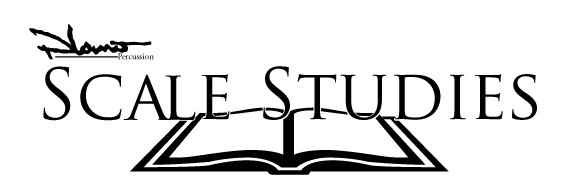Welcome to the Plano Scales Studies Page!
Success behind a keyboard percussion instrument, much like most musical instruments, begins with understanding fluidity of motion and connection
to the instrument. Movement around a keyboard percussion instrument, when more comfortable, allows the player to develop the fine motor skills
needed to convey musical material. An artistic sense of useful musical structure begins with the development of scale understanding. From this
understanding comes the ideas of keys, translation, deciphering, and transference.
Our ears have heard different types of scales for quite some time through the music of our lives. Happy, sad, mysterious, or wistful, scales play
a crucial part in conveying these emotions. Major, minor, diminished, augmented, or modal, scales are our foundation to organizing musical thought.
Our KBP Advantage: We See What We Hear and Read
Our musical alphabet is found directly in front of us when it comes to playing a keyboard percussion instrument. Lower tones are found to the left
of where we stand. Higher tones are to the right. The two rows of bars/notes represent natural notes, closest to us on the lower row, and
accidentals or sharps and flats, are those found on the upper row, slightly further away from us.
The material found here serves as supplemental resources to continue skills and ideas learned in your beginner classes, lessons, or other musical
influences. The following are a few reminders.
The distance of half steps occur between naturals and accidentals
A whole step exists between natural to natural or accidental to accidental except between B & C and E-F.
The distances between B-C and E-F are called natural half steps
Start the mastery of motion with each hand, singularly, then proceed to an alternating system.
Regardless of experience, learning and maintaining scales becomes easier when you understand the basics. Invest time to understand them and learn to play them well. It will
make music making and creating much more satisfying.
Diminished Scales: A Basic Explanation
A diminished scale is comprised of eight (8) notes and built by alternating half-steps and whole steps. Names such as "Octatonic Scale" and "Half-Whole Scale" are
used as different means to identify the same diminished scale idea presented here. Starting on "C," the scale moves up a half-step, then a whole-step, then
half, then whole, etc
The reality is there are only 3 diminished scales - C, C#, & D.
Build a scale on D# and the same scale as the C diminished scale results.
The same results occur with subsequent starting notes.
Pentatonic Scales: Popular in Many Music Styles
Very similar to the natural minor scale, the minor pentatonic scale omits half-step intervals such as those found on the 2nd scale degree and the b6th
(flat 6th) scale degree.
2nd to 3rd scale degrees = 1/2 step; omitted
6th to 7th scale degrees = 1/2 step; omitted
Both minor and major pentatonic scales exist. The rules of major to relative minor are the same when working pentatonic scales.
"A Minor pentatonic" has identical notes as "C Major pentatonic" but in different order.
"D Minor pentatonic" has identical notes as "F Major pentatonic" but in different order.
This theory makes memorization easier.
|

